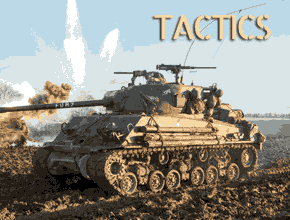The Sd. Kfz. 265 also called kleiner Panzerbefehlswagen refers to a series of different types of armored radio and command vehicle based on the German Panzerkampfwagen I, which was developed before the Second World War, and manufactured until the end of 1937. This interesting, but somewhat extreme conversion was used until 1945, but the approach was discontinued for simpler tank conversions (Befehlspanzer).

![]()

The radio equipment consisted of a 20-watt transmitter (abbreviated: 20W.S.c/24b-123/LS20/123) with a range of four to six kilometers and two VHF receivers. These two receivers were replaced from the beginning of 1939 onwards with a Telefunken VHF receiver e "Emil" (abbreviated: VHF. E. e – TE/325 – E443Bs). Both the transmitter C and the receiver E were designated as the Fu 6 SE 20 U set (abbreviated: Fu 6), which stands for Funkgerätsatz 6, Sender-Empfänger, 20-Watt, UKW. Also characteristic was the two-meter-long rod antenna with its corresponding antenna guard on the right side of the vehicle. The antenna could be folded down and securely anchored there. Some variants featured other antenna shapes as well as different versions of the loop antenna.
Access to the combat and radio compartment was through a double door on the left side of the vehicle. On the right side was a small, spherical hatch for receiving and transmitting messages under armor protection. The vision windows were made of nine-centimeter-thick armored glass. To shield these windows from sun and rain on the later-added commander's cupola, small "roofs" were constructed around the cupola.
On December 1, 1940, the 1st Mine Clearance Battalion was formed in Wissembourg, Alsace, from the existing mine clearing company. Its unit consisted of twenty-two small Panzer Command Vehicles I (eleven per company, according to the wartime strength record of 1159), serving as command vehicles for the remotely controlled Sd.Kfz. 300s.
The unit was transferred to East Prussia on June 18, 1941, and during the attack on the Soviet Union in the Grodno area, it was subordinated to the XXXIX Motorized Army Corps. One company was deployed to support an infantry unit in the capture of Grodno, and the second company to support armored troops advancing towards Vilnius. On July 5, 1941, radio command tanks directed the deployment of amphibious mine-clearing tanks, nicknamed "Ente," across the Daugava River near Beshankovichi during the advance on Vitebsk. As early as July 8, the unit was withdrawn and sent back to Wunsdorf via Vilnius to the Treuburg railway station. Five of the radio command tanks remained behind and were placed under the command of Panzer Group 3.
As radio command tanks, the Sd.Kfz. 265s were fitted with a command transmitter mounted in armored boxes behind the superstructure for controlling the remotely controlled vehicles, as well as an additional antenna. To better monitor the remotely controlled vehicles from inside the vehicle, a movable periscope was installed in the left commander's hatch cover, which was also used in the Panzerkampfwagen 38(t).

Between 1935 and 1940, the small Panzerbefehlswagen I (Little Panzer Command Car I) was the standard command vehicle in Panzer divisions. Three vehicles were assigned to the headquarters of a Panzer regiment, two to the headquarters of a Panzer battalion, and one to each Panzer company. From 1940 onward, however, the small Panzerbefehlswagen I was only available at the company level. Some vehicles were transferred as early as 1940 to the signal battalions and observation batteries of the artillery regiments of Panzer divisions.
The first four models built saw their first combat use during the Spanish Civil War from the summer of 1936 to the end of 1937. The small Panzerbefehlswagen I saw official combat during the Polish Campaign of 1939. However, it quickly became apparent that the small and cramped vehicle no longer met the requirements of the time, so many of the Panzerbefehlswagen were converted into ambulance tanks. At the start of the invasion of the Netherlands and France, 96 of the 184 vehicles produced were still in service as command vehicles.
The small armored command vehicle also saw action in North Africa. A special filter system was installed to keep sand away from the engine. The last active campaign for the armored command vehicle began in 1941 with Operation Barbarossa, the invasion of the Soviet Union. As the vehicle could no longer keep pace with advances in tank technology, the last remaining vehicles were withdrawn from active service with the Panzer divisions by early 1942 and used for training purposes. Some already decommissioned command vehicles were also repurposed as ammunition carriers or ambulances. In urgent emergencies, the ambulance could be used as a transport vehicle, but its primary function was rescuing wounded soldiers from the front lines. For this purpose, medical equipment was installed, and a doctor was on board instead of a radio operator.
The only collection in which, to our knowledge, a small Panzer Command Vehicle (Kleiner Panzerbefk.Wg.) still exists in its original form is that of the Tank Museum Bovington. The vehicle was likely used by the 3rd Panzer Division in the 1940 Western Campaign against France. As the command vehicle of Panzer Regiment 5, which was detached in January 1941 to form the 5th Light Division, it arrived with this unit in the port of Tripoli, Libya, in March 1941. With the formation of the 21st Panzer Division through the reorganization and reinforcement of the 5th Light Division in August 1941, it became a vehicle of this division.
The vehicle was likely used by the 3rd Panzer Division in the Western Campaign against France in 1940. At the end of 1941, during the British relief attack to liberate besieged Tobruk, Operation Crusader, it fell into the hands of British forces and was transported by sea to the central British armored vehicle school, the Armoured Fighting Vehicles School, in Bovington. There, the vehicle underwent thorough examination and testing.
On display is the vehicle with the designation I03, which indicates a staff vehicle of the 1st Battalion. Today's presentation features a paint scheme of Panzer Grey RAL 7021 (Dark Grey RAL 46) with cloudy application of Signal Brown RAL 8002, typical of the years 1935 to 1939. According to Army Bulletin No. 864, a uniform Panzer Grey paint scheme was planned for the vehicle from June 30, 1940. It is now inaccurate that this vehicle has a tropical camouflage scheme, which was only used by the units deployed to North Africa from February 1941 onwards.
Until 2005, it was still displayed in the colors of the North African theater of war. Army Bulletin No. 281, issued on March 17, 1941, regarding the Africa camouflage pattern, would have been the relevant regulation for the vehicle's paint scheme. This bulletin prescribed a base coat of RAL 8000 yellow-brown and a cloudy camouflage pattern of RAL 7008 gray-green. However, this was often not implemented according to regulations.

Development
Based on the development and introduction of the "agricultural tractor" Panzerkampfwagen I Ausf. A in 1934, a command vehicle was envisioned for the newly created Panzerdivisions. It was equipped with radios to be used as commander and operating directly behind or within the mobile combat unit. It seemed logical to mount this vehicle on the same chassis as current tanks used by then. This would ensure the same cruising speed and allow maintenance units to service these with minimal effort. However, the development of the platoon commander's vehicle (Panzerkampfwagen III), already planned as a command vehicle was delayed, so the chassis of the Panzerkampfwagen I Ausf. A (2nd series/La. S.) was used. The correspondingly modified vehicle became known as the 'Light (Radio) Armored Car'.Design
Layout
On the first vehicles, the turret was removed, replaced with an angular casemate build over the original superstructure. Space was provided for several radios, which could vary depending on the role of the individual vehicle. A small series of six vehicles were built and tested. Trials were promising, but the Ausf. A vehicles were increasingly replaced by the new and improved Pz. Kpfw. I Ausf. B. Therefore, further designs were developed for a vehicle based on this chassis. This vehicle also had a rigid rectangular superstructure with radios instead of a machine gun turret, but this superstructure extended across the entire width of the vehicle. This octagonal superstructure was then attached to the hull with bolted connections. This provided space in the vehicle for a radio operator in addition to the driver and commander, who could react immediately to the commander's information and transmit situation reports to superiors at division headquarters via radio.Engine and performances
The small command tank was powered by a water-cooled, 6-cylinder Maybach NL 38 Tr engine producing 100 hp at 3000 rpm. The transmission was a ZF F.G. 31 with five forward gears and one reverse gear. With the Maybach engine, the command tank reached a top speed of 40 km/h on roads and a range of 170 km. Off-road, it could reach speeds of up to 15 km/h and travel up to 115 km. The small command tank could easily traverse inclines of up to 30°. It could also cross trenches 1.40 m long and steps up to 37 cm high. Like the Panzer I Ausf. B, the small Panzer command vehicle could climb gradients of up to 30° and cross ditches up to 1.40 m deep. The tank had a ground clearance of 30 cm and a fording depth of up to 60 cm.Equipment

The radio equipment consisted of a 20-watt transmitter (abbreviated: 20W.S.c/24b-123/LS20/123) with a range of four to six kilometers and two VHF receivers. These two receivers were replaced from the beginning of 1939 onwards with a Telefunken VHF receiver e "Emil" (abbreviated: VHF. E. e – TE/325 – E443Bs). Both the transmitter C and the receiver E were designated as the Fu 6 SE 20 U set (abbreviated: Fu 6), which stands for Funkgerätsatz 6, Sender-Empfänger, 20-Watt, UKW. Also characteristic was the two-meter-long rod antenna with its corresponding antenna guard on the right side of the vehicle. The antenna could be folded down and securely anchored there. Some variants featured other antenna shapes as well as different versions of the loop antenna.
Access to the combat and radio compartment was through a double door on the left side of the vehicle. On the right side was a small, spherical hatch for receiving and transmitting messages under armor protection. The vision windows were made of nine-centimeter-thick armored glass. To shield these windows from sun and rain on the later-added commander's cupola, small "roofs" were constructed around the cupola.
Armament
For close-range defense, a single MG 34 machine gun, mounted in a ball mount, was installed on the upper right side of the new superstructure. The radio operator operated the machine gun. The MG 34 carried 900 rounds of ammunition (twelve magazines of 75 rounds each). A K.Z.F. 1 reticle was provided for aiming. In practice, the machine gun was often removed to create more interior space. The armor was 13 mm thick, the same as on the standard Panzer I versions. The new superstructure received 14 mm of all-around armor.Production and variants
Series production began in 1935 on the chassis of the Ausf. B and continued until December 1937. A total of 184 small Panzerbefehlswagen I (Kfz. I) were built. Daimler-Benz (chassis and final assembly), Deutsche Edelstahlwerke AG in Hannover-Linden (welding and bodywork), Krupp in Essen (chassis), and Henschel in Kassel (chassis) were involved in the production. The Production took place in three series:1st Series/kl.Pz.Bef.Wg.
25 units: chassis numbers: 9406–9430) – manufactured by Krupp on the chassis of the 4a Series/La. S. of the Panzerkampfwagen I.2nd Series/kl.Pz.Bef.Wg.
30 units: Chassis numbers: 10478–10497/10506–10512/10514–10518/10522) manufactured by Daimler-Benz on the chassis of the 5th series/La. S. of the Panzerkampfwagen I.2nd series/kl.Pz.Bef.Wg.
1 unit: Chassis number: 12521) manufactured by Henschel on the chassis of the 5th series/La. S. of the Panzerkampfwagen I.2nd series/kl.Pz.Bef.Wg.
16 units: Chassis numbers: 14507–14510/14515–14517/14519–14520/14522–14528) manufactured by Krupp on the chassis of the 5th series/La. Sub-series of the Panzerkampfwagen I.3rd series/kl.Pz.Bef.Wg.
44 units: chassis numbers: 15001–15044) manufactured by Daimler-Benz on the chassis of the 7a series/La. Sub-series of the Panzerkampfwagen I.3rd series/kl.Pz.Bef.Wg.
68 units: chassis numbers: 15101–15168 manufactured by Henschel on the chassis of the 7a series/La. Sub-series of the Panzerkampfwagen I.Variants
Over time, the versions of the small armored command vehicle (Sd.Kfz.265) (kl.Pz.Bef.Wg.) were further upgraded, for example:kl.Pz.Bef.Wg. (Sd.Kfz.265) (1st series)
This variant had the boxy superstructure and the MG 34 machine gun, but no commander's cupola, which severely limited all-around visibility under armor protection.kl.Pz.Bef.Wg. (Sd.Kfz.265) (1st series)
With frame antenna – To increase the radio range, a frame antenna was fitted around the vehicle in a field modification.kl.Pz.Bef.Wg. (Sd.Kfz.265) (2nd series)
This variant had the boxy superstructure and the MG 34 machine gun, and additionally a slightly raised cupola for the commander. This allowed him to survey the battlefield while protected.Small Command Vehicle (Sd.Kfz. 265) (2nd Series)
With frame antenna – As with the early variant, a frame antenna was fitted to increase the range and reduce susceptibility to interference.Small Command Vehicle (Sd.Kfz. 265) (3rd Series)
This variant had the box-shaped superstructure, the MG 34 machine gun, and a further raised commander's cupola, which improved the field of vision even more. Additionally, there was an armored box at the rear to house the radio equipment. This freed up space in the interior.Small Command Vehicle (Sd.Kfz. 265) (3rd Series)
With frame antenna – As with the two preceding variants, a frame antenna was fitted to increase the range and reduce susceptibility to interference.Small command vehicle (Sd.Kfz. 265) (3rd series)
With additional armor – Its vulnerability to enemy fire was already evident during the Polish campaign. To increase the armor, 15 mm thick additional armor was fitted to the front of the superstructure and the front of the chassis. This increased the frontal armor to 30 mm, but also increased the weight of the tank.Sd.Kfz. 265 (3rd series)
Tropical – Since the command vehicle was also used in Africa, special filters had to be fitted to the engine deck to keep the fine desert sand as far away from the engine as possible.Funkleitpanzer kl.Pz.Bef.Wg. (Sd.Kfz.265)
In preparation for the attack on the French Maginot Line, the Wehrmacht had been working on technical solutions for clearing minefields and destroying bunkers. The Glienecke Mine Clearance Company was established for the deployment of remotely controlled vehicles. This company was equipped with Sd.Kfz. 300 mine clearers, developed by the Borgward company.On December 1, 1940, the 1st Mine Clearance Battalion was formed in Wissembourg, Alsace, from the existing mine clearing company. Its unit consisted of twenty-two small Panzer Command Vehicles I (eleven per company, according to the wartime strength record of 1159), serving as command vehicles for the remotely controlled Sd.Kfz. 300s.
The unit was transferred to East Prussia on June 18, 1941, and during the attack on the Soviet Union in the Grodno area, it was subordinated to the XXXIX Motorized Army Corps. One company was deployed to support an infantry unit in the capture of Grodno, and the second company to support armored troops advancing towards Vilnius. On July 5, 1941, radio command tanks directed the deployment of amphibious mine-clearing tanks, nicknamed "Ente," across the Daugava River near Beshankovichi during the advance on Vitebsk. As early as July 8, the unit was withdrawn and sent back to Wunsdorf via Vilnius to the Treuburg railway station. Five of the radio command tanks remained behind and were placed under the command of Panzer Group 3.
As radio command tanks, the Sd.Kfz. 265s were fitted with a command transmitter mounted in armored boxes behind the superstructure for controlling the remotely controlled vehicles, as well as an additional antenna. To better monitor the remotely controlled vehicles from inside the vehicle, a movable periscope was installed in the left commander's hatch cover, which was also used in the Panzerkampfwagen 38(t).
Sd.Kfz.265 specifications | |
| Dimensions | 4.445 x 2.08 x 1.72 m (14 ft 7 in x 6 ft 10 in x 5 ft 8 in) |
| Weight | 5.8 tonnes (6.4 short tons; 5.7 long tons) |
| Crew | 3: Commander, Driver and Radio Operator |
| Propulsion | Maybach NL38TR inline 6-cyl wt gasoline: 100 hp (74 kW) |
| Suspension | Quarter-elliptical leaf spring suspension. |
| Maximum speed | 40 km/h (25 mph) on-road |
| Range | 290 km (180 mi) |
| Armament | 7.92 mm MG13 machine gun |
| Armor | 6 to 13 mm (0.24 to 0.51 in) |
| Total production | 183 |
Combat Deployment

Between 1935 and 1940, the small Panzerbefehlswagen I (Little Panzer Command Car I) was the standard command vehicle in Panzer divisions. Three vehicles were assigned to the headquarters of a Panzer regiment, two to the headquarters of a Panzer battalion, and one to each Panzer company. From 1940 onward, however, the small Panzerbefehlswagen I was only available at the company level. Some vehicles were transferred as early as 1940 to the signal battalions and observation batteries of the artillery regiments of Panzer divisions.
The first four models built saw their first combat use during the Spanish Civil War from the summer of 1936 to the end of 1937. The small Panzerbefehlswagen I saw official combat during the Polish Campaign of 1939. However, it quickly became apparent that the small and cramped vehicle no longer met the requirements of the time, so many of the Panzerbefehlswagen were converted into ambulance tanks. At the start of the invasion of the Netherlands and France, 96 of the 184 vehicles produced were still in service as command vehicles.
The small armored command vehicle also saw action in North Africa. A special filter system was installed to keep sand away from the engine. The last active campaign for the armored command vehicle began in 1941 with Operation Barbarossa, the invasion of the Soviet Union. As the vehicle could no longer keep pace with advances in tank technology, the last remaining vehicles were withdrawn from active service with the Panzer divisions by early 1942 and used for training purposes. Some already decommissioned command vehicles were also repurposed as ammunition carriers or ambulances. In urgent emergencies, the ambulance could be used as a transport vehicle, but its primary function was rescuing wounded soldiers from the front lines. For this purpose, medical equipment was installed, and a doctor was on board instead of a radio operator.
Preserved Vehicles

The only collection in which, to our knowledge, a small Panzer Command Vehicle (Kleiner Panzerbefk.Wg.) still exists in its original form is that of the Tank Museum Bovington. The vehicle was likely used by the 3rd Panzer Division in the 1940 Western Campaign against France. As the command vehicle of Panzer Regiment 5, which was detached in January 1941 to form the 5th Light Division, it arrived with this unit in the port of Tripoli, Libya, in March 1941. With the formation of the 21st Panzer Division through the reorganization and reinforcement of the 5th Light Division in August 1941, it became a vehicle of this division.
The vehicle was likely used by the 3rd Panzer Division in the Western Campaign against France in 1940. At the end of 1941, during the British relief attack to liberate besieged Tobruk, Operation Crusader, it fell into the hands of British forces and was transported by sea to the central British armored vehicle school, the Armoured Fighting Vehicles School, in Bovington. There, the vehicle underwent thorough examination and testing.
On display is the vehicle with the designation I03, which indicates a staff vehicle of the 1st Battalion. Today's presentation features a paint scheme of Panzer Grey RAL 7021 (Dark Grey RAL 46) with cloudy application of Signal Brown RAL 8002, typical of the years 1935 to 1939. According to Army Bulletin No. 864, a uniform Panzer Grey paint scheme was planned for the vehicle from June 30, 1940. It is now inaccurate that this vehicle has a tropical camouflage scheme, which was only used by the units deployed to North Africa from February 1941 onwards.
Until 2005, it was still displayed in the colors of the North African theater of war. Army Bulletin No. 281, issued on March 17, 1941, regarding the Africa camouflage pattern, would have been the relevant regulation for the vehicle's paint scheme. This bulletin prescribed a base coat of RAL 8000 yellow-brown and a cloudy camouflage pattern of RAL 7008 gray-green. However, this was often not implemented according to regulations.
Gallery
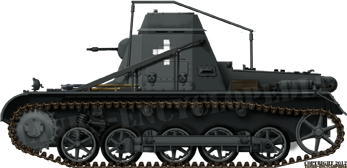
Kleiner Panzerbefehlswagen ausf B, Balkans April 1941.






In spain

Design 3D

modele Ausf B

In Russia

Befehlspanzer_1_auf_Landstrae

Befehlspanzer_I in Poland

Filmberichter_im_Panzer_I

Flickr_-_davehighbury_-_Bovington

Panzer_I_Ausf_B

SdKfz_265_Panzerbefehlswagen_I_Ausf_B
Links
Peter Chamberlain, Hilary L. Doyle: Enzyklopädie der deutschen Panzer des Zweiten Weltkriegs. 1999.Wolfgang Fleischer: Waffen-Arsenal Sonderband S-48: Panzerkampfwagen I und seine Abarten. Podzun Verlag, 1997
Henry Hoppe: Kleiner Panzer-Befehlswagen Sd.Kfz. 265. In: Tankograd - Wehrmacht Special - Deutsche Fahrzeugraritäten (2). Band 4002. Tankograd Publishing, Erlangen 2004.
Markus Jaugitz: Waffen-Arsenal Special Band 10: Die deutsche Fernlenktrupp 1940–1943. Podzun Verlag, 1994
Thomas L. Jentz, Hilary L. Doyle: Panzer Tracts No. 01 – 2, Panzerkampfwagen I – Kl.Pz.Bef.Wg. bis VK 18.01. 2002
Fred Koch: Waffen-Arsenal Special Band 20: Gepanzerte Funkwagen und Befehlspanzer in der Wehrmacht. Podzun Verlag, 1997
Walter J. Spielberger, Hilary L. Doyle: Panzer I und II und ihre Abarten. Motorbuch Verlag, 2014
tanks-encyclopedia.com (Panzer I)
en.wikipedia.org
radiomuseum.org
radiomuseum.org
de.wikipedia.org
commons.wikimedia.org
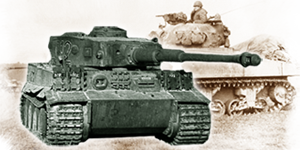
WW2 Tanks




























WW2 tanks posters
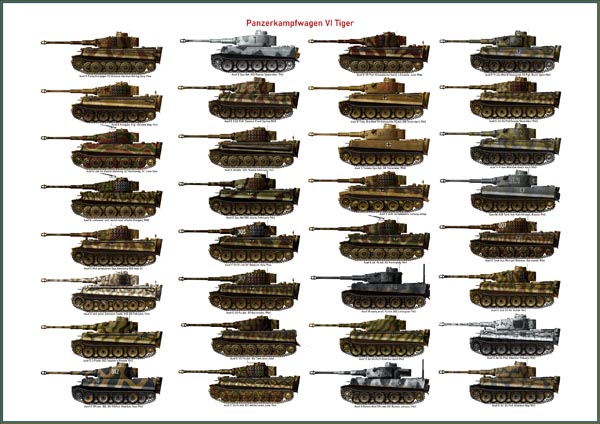
All Tiger tanks liveries.

Panther liveries and variants

WW2 Armour - All tanks
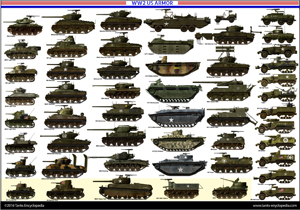

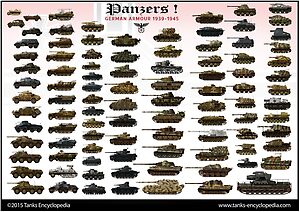








Tanks aces and single tanks series

Find more there

Museums, Movies, Books & Games
The Tanks and Armor in pop culture
Tanks and armored vehicles in general are only really grasped when seen first person: The mass, the scale, it's all there. Explore also the way tanks were covered in the movie industry, in books and in video games.Movies:
Best tanks movie on warhistoryonline.com
On imdb.com
On bestsimilar.com/
miltours.com
liveabout.com/
watchmojo.com
Video Games:
pcgamesn.com
historyhit.com
levvvel.com
vg247.com/best-tank-games
mmobomb.com/
alienwarearena.com
